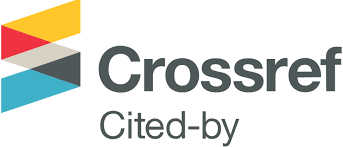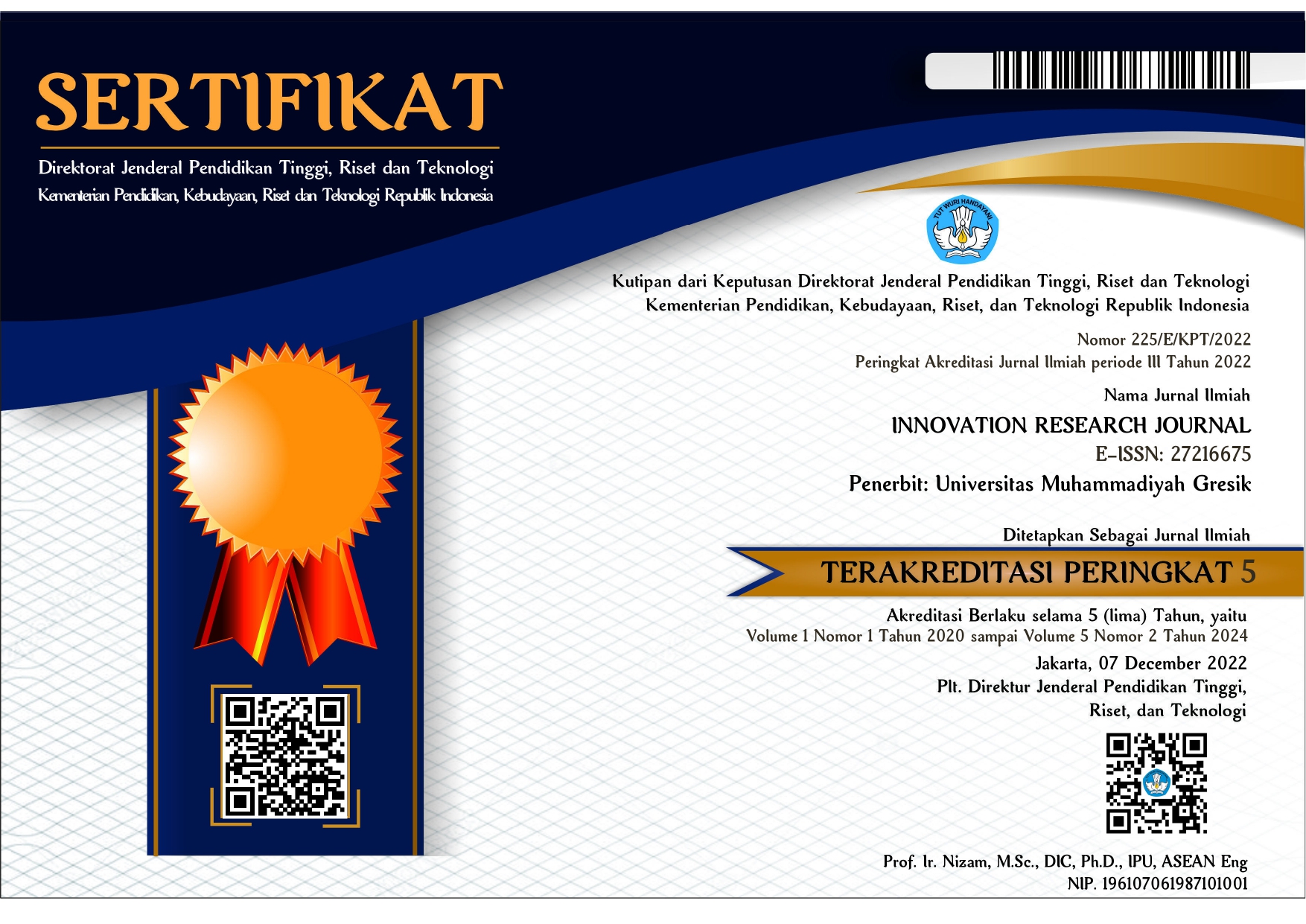Program ODOPOS ( One Day One Problem One Solution) In Realistic Mathematics-Based Online
DOI:
https://doi.org/10.30587/innovation.v1i2.1916Keywords:
: Realistic mathematic, ODOPOS program, e-learning, student achievementAbstract
ABSTRAK
The purpose of this research is to develop ODOPOS (one day one problem one solution) program in realistic mathematic that is based online. By application of realistic mathematics is expected to have students the ability to understand mathematics in real life.
The sample of this study is 33 students at V grade of Elementary School of Muhammadiyah Manyar at 2019-2020 academic years. The research instrument is a pretest-posttest test and student response questionnaire sheet.
Result of the study: (1) Development of ODOPOS (one day one problem one solution) program in realistic mathematic based online is: (a) Analyze stage, includes analysis of student characteristics and material analysis (b) Design stage, there is a use case diagram that is: home, profile, log in, summary and examples of problems, exercises, scores and class progress (c) Development stage is developing the ODOPOS program design based on the use case diagram. (d) Implementation stage, is the result of the development ODOPOS program being applied in learning for one week (e) evaluation stage, is giving a pretest-posttest test and student questionnaire response sheet (2) there is an increase in student achievement 84 , 84%. The students get an n-gain score of 0.7 for the high category from the use of the ODOPOS (one day one problem one solution) program. (3) Students responses to the ODOPOS program, based on the content criteria, the result is 93.49% or very feasible
References
Jennings, Sue & R, Dunne. 1999. Math Stories, Real Stories, Real-life Stories . http://www.ex.ac.uk/telematics/T3/mathsactar01.htm .
Murdiani, 2018 . Improving Motivation and Learning Outcomes Adding Fractions Through the Cooperative Learning Model Type Make A Match Grade IV Students of SDN Hariang, Banua Lawas District, Tabalong Regency . Sogacious Scientific Journal of Education and Social Vol.4 No. January 2-June 2018.
Nasution, 2011. Various Approaches in the Learning and Teaching Process . Jakarta: PT. Earth Literacy.
Ningsih, Seri. 2014. Realistic Mathematic Education : Alternative Models of School Mathematics Learning. JPM IAIN Antasari Vol.01 No. 2 p. 73-94.
Riduwan, Mohamad. 2012. Mathematical Planning and Development . Medan: PT. SOFMEDIA
Soedjadi. 2000. Tips on Mathematics Education in Indonesia . Jakarta: Directorate. General of Higher Education Ministry of National Education.
Sugiyono, 2009. Educational Research Methods Quantitative, Qualitative, and R&D Approaches . Bandung: Alfabeta.
Tegeh, Made, et al. 2014. Development Research Model . Yogyakarta: Graha knowledge.
Ahmad, A. B. (2018). Citra Destinasi Dan Pengaruhnya Terhadap Intensi Untuk Berkunjung Kembali Di Sulawesi Selatan Sebagai Destinasi Pariwisata. Sosiohumaniora, 20(3), 207-214.
Ariyanto. (2005). Ekonomi Pariwisata.
Jakarta: Penerbit Rineka Cipta
Charo, N., Sharma, P., Shaikh, S., Haseeb, A., dan Sufya, M. Z. (2015). Determining the Impact of E-wom on Brand Image and Purchase Intention through Adoption of Online Opinions. 3(1).
Chen, C and Tsai, D. (2007). Manajemen Pemasaran Jasa. Kelompok Gramedia: indeks.
Cheung, C. M & Lee, M. K. (2012). What drives consumers to spread electronic word of mouth in online consumer- opinion platforms. Decision support systems, 53(1), 218-225.f Interactive Advertising, Vol. 6 No. 2,pp. 1-6.
Deksono, Favian Rachmadi. (2017). Pengaruh Motivasi Wisata dan Electronic Word Of Mouth Terhadap Minat Berkunjung ke Daya Tarik Goa Pindul. Skripsi Universitas Sanata Dharma. Yogyakarta.
Dewi. Indriyani Ratna. (2018). Pengaruh Electronic Word Of Mouth, Citra Destinasi Dan Fasilitas Wisata Terhadap Keputusan Berkunjung Yang Dimediasi Oleh Respon Emosional (Studi pada Pengunjung Wahana Air Lampung Walk Bandar Lampung). Skripsi Universitas Lampung Bandar Lampung.
Echtner, Charlotte M dan J.R. Brent Ritchie. (2003). The meaning and measurement of destination image.
The journal of tourism studies vol.14, no.1 may 03. Canada
Fitroh, S. K. A., Hamid, D., & Hakim, L. (2017). Pengaruh Atraksi Wisata dan Motivasi Wisatawan Terhadap Keputusan Berkunjung (Survei pada Pengunjung Wisata Alam Kawah Ijen). Jurnal Administrasi Bisnis, 42(2), 18-25.
Ghozali, Imam. (2016). Aplikasi Analisis Multivariete Dengan Program IBM SPSS 23 (Edisi 8). Cetakan ke VIII. Semarang : Badan Penerbit Universitas Diponegoro.
Hailin, Qu., Kim, L.H., Im, H.H. (2011).
“A model ofdestination branding: integreting the concepts of the branding and destination image”, Tourism Management, Vol.32,pp. 465-475.
Hasan, A., & Setiyaningtiyas, N. W. (2015). Pengaruh Electronic Word of Mouth pada Media Sosial Facebook terhadap Keputusan Berkunjung ke Desa Wisata Nglanggeran Gunungkidul. Jurnal Media Wisata: Wahana Informasi Pariwisata, 13(1).
Hennig-Thurau, Kevin Gwinner., Gianfranco Walsh., and Dwayne Gremler. (2004). Electronic Word of Mouth Via Consumer Opinion Platform : What Motivates Consumers To Articulate Themselves on The Internet ?.Journal of Interactive Marketing.38:52.
Humaira, A., & Wibowo, L. A. (2016). Analisis Faktor Elektronik Word Of Mouth (EWOM) Dalam Mempengaruhi Keputusan Berkunjung Wisatawan. THE Journal: Tourism and Hospitality Essentials Journal, 6(2), 1049-1060.
Jalilvand, M. R and Samiei, N. (2012). The Effect of Electronic Word Of Mouth on Brand Image and Purchase Intention: An Empirical Study in The Automobile Industry in Iran”. Marketing Intelligence & Planning, Vol. 30 No. 4, pp. 460-47
Keliwar, S., & Nurcahyo, A. (2015). Motivasi dan Persepsi Pengunjung terhadap Obyek Wisata Desa Budaya Pampang di Samarinda. Jurnal Manajemen Resort dan Leisure, 12(2). Kotler, Philip, dan Gary Armstrong. (2001). Prinsip-Prinsip Pemasaran. Edisi 12.
Jakarta: Erlangga
Kotler, Philip, dan Gary Armstrong. (2004). Dasar-dasar pemasaran. Jakarta: PT Indeks
Kotler, Philip. (2005). Manajemen Pemasaran. Jilid I. Jakarta: PT.Indeks
Kusuma, I. G. A. R. D., & Suryasih, I. A. 2016. Aktivitas Wisata Spiritual dan Motivasi Berwisata Di Daya Tarik Wisata Tanah Lot Kabupaten Tabanan. Jurnal Destinasi Pariwisata, 4(2), 118-122.
Malik. Moh. Ibram dan M. Kholid Marwadi. (2016). Penagrud City Branding “The Soul Of Madura dan terhadap Keputusan Berkunjung Ke Kabupaten Sumenep. Jurnal Administrasi Bisnis. Vol. 37. (Agustus) No. 1
Mcdaniel, Lamb dan Hair. (2001). Pemasaran Buku Satu. Jakarta: Salemba Empat
Mowen, John C dan Michael Minor. (2002), Perilaku Konsumen (Jilid 1), Edisi Kelima. Jakarta: Erlangga.
Oka A. Yoeti. (2008). Perencanaa dan pengembangan pariwisata. Jakarta: PT Pradnya Paramita
Peter, J Paul dan Jerry C Olson. (2000). Perilaku Konsumen dan Strategi Pemasaran. Edisi 4, jilid 1. Jakarta: Erlangga
Republik indonesia. (2009). Undang – Undang No. 11 Tahun 2009 Tentang Kepariwisataan. Lembaran Negara republik indonesia tahun 2009. No 11 Sekertariat Negara: Jakarta
Sangadji, E.M dan Sopiah. (2013). Prilaku Konsumen: Pendekatan Praktis Disertai: Himpunan Jurnal Penelitian. Yogyakarta: Penerbit Andi










